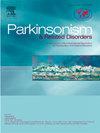Taxonomic intestinal microbiota differences in Lewy body spectrum disease and cohabitant controls
IF 3.1
3区 医学
Q2 CLINICAL NEUROLOGY
引用次数: 0
Abstract
Background
Microbial dysbiosis has been reported to contribute to development of neurodegenerative diseases, however, there is a need to identify causative/prognostic indicators.
Objectives
To comparatively analyze gut microbiome composition in symptomatic LBD (dementia/mild cognitive impairment), iRBD, and cohabiting controls without LBD or iRBD.
Methods
16S rRNA amplicon sequencing was performed in 38 cases (27 LBD, 11 iRBD) and 39 cohabitant controls. 19 non-cohabitant healthy controls (HCs) were also included to contrast differences between cohabitant cases and controls.
Results
Microbiome composition of cohabitant controls and LBD and iRBD cases were strikingly similar. No differences were observed between LBD, and iRBD only showed reduced Bacteroides, compared with cohabitant controls. There were several taxonomic differences in gut microbiome composition between non-cohabitant HCs and cases.
Conclusions
Minimal microbiome differences were observed between iRBD or LBD cases and cohabitant controls. These findings underscore the importance of using cohabiting controls in future gut microbiome studies.
路易体谱系疾病与同居对照组的肠道微生物群分类差异。
背景:据报道,微生物菌群失调是导致神经退行性疾病发生的原因之一,但目前还需要确定致病/诊断指标:方法:对 38 例病例(27 例 LBD,11 例 iRBD)和 39 例同居对照进行 16S rRNA 扩增片测序。为了对比同居病例和对照组之间的差异,还纳入了 19 个非同居健康对照组(HCs):结果:同居对照组、枸杞多糖病例和 iRBD 病例的微生物组组成非常相似。与同居对照组相比,枸杞多糖病例和 iRBD 病例之间未观察到差异,而 iRBD 病例仅显示出 Bacteroides 减少。非同居 HC 与病例之间的肠道微生物组组成在分类学上存在一些差异:在 iRBD 或 LBD 病例与同居对照之间观察到的微生物组差异极小。这些发现强调了在未来的肠道微生物组研究中使用同居对照的重要性。
本文章由计算机程序翻译,如有差异,请以英文原文为准。
求助全文
约1分钟内获得全文
求助全文
来源期刊

Parkinsonism & related disorders
医学-临床神经学
CiteScore
6.20
自引率
4.90%
发文量
292
审稿时长
39 days
期刊介绍:
Parkinsonism & Related Disorders publishes the results of basic and clinical research contributing to the understanding, diagnosis and treatment of all neurodegenerative syndromes in which Parkinsonism, Essential Tremor or related movement disorders may be a feature. Regular features will include: Review Articles, Point of View articles, Full-length Articles, Short Communications, Case Reports and Letter to the Editor.
 求助内容:
求助内容: 应助结果提醒方式:
应助结果提醒方式:


